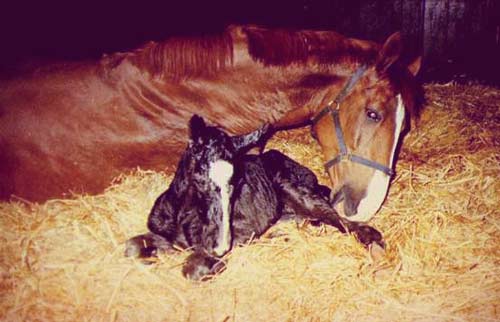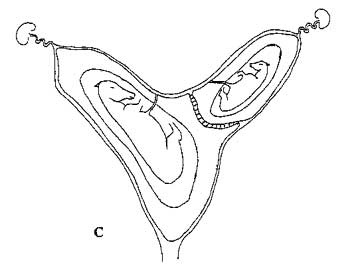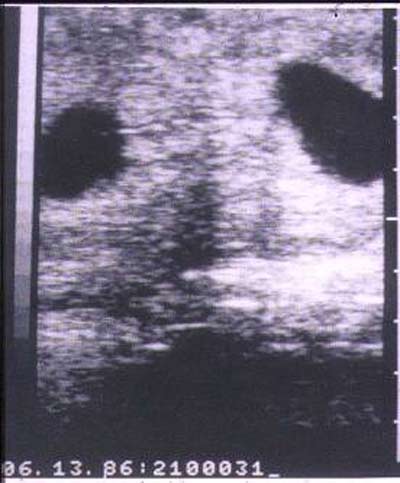Incidence of twin pregnancies
Twinning is an increasing problem
in stud management, especially in intensively bred horses
such as Thoroughbreds, Arabs and Warmbloods. Twin pregnancies
result from the fertilisation of two ova. The incidence of
twin ovulations, and, therefore, twin pregnancies, varies
significantly with breed and age of mare. It has been reported
that only 1% of oestrous cycles in pony mares result in a
multiple ovulation (MO) whereas in Thoroughbred, Arab and
Warmblood horses up to 40% of cycles demonstrate MO. The incidence
of MO also increases with age. All these ovulations have the
potential to be fertilised and result in pregnancy. Mortality
of some of these twin embryos does naturally occur, as will
be discussed later, but as most mares are scanned very early
in pregnancy (Day14-20 p.c.) the incidence of twin pregnancies
is very similar to, and follows the same pattern as, multiple
ovulation. As all these pregnancies have the chance to develop
further and it is not possible at this stage to accurately
identify those that will naturally die, all twin pregnancies
must be considered to be of concern. Additionally it
is increasingly evident that twinning is a heritable trait.

Why are twin pregnancies a problem in the
mare?
The mare is classified as monocotous, her uterus only being
able to adequately support a singleton. The placenta for that
pregnancy needs to attach to the entire surface of the uterus
in order to satisfy the demands of the foetus, especially
in the last trimester. The development of a twin pregnancy
results in the surface of the uterus available to each placenta
being reduced, so compromising foetal development and ultimately
survival. Hence twin pregnancies rarely survive to term, most
commonly resulting in abortion in mid to late pregnancy (9-10months).
They are in fact the most common cause of non-infectious abortion,
accounting for 20-30% of all occurrences. Only 9% of twin
pregnancies survive to term: 64.5% of which result in 2 dead
foals, 21% in one live foal and 14.5% in 2 live foals.
Twin pregnancies, like multiple
ovulations can be classified as unilateral, both in the same
horn, or bilateral one in each. 70% of pregnancies are reported
to be unilateral and 30% bilateral. With regard to the possible
prognosis of a twin pregnancy they can be further classified
into: i) equal division of the uterus (50%:50%); ii) minor
unequal division of the uterus (40%:60%); iii) or major unequal
division of the uterus (20%:80%) (Figure 1).
i)
Equal division of the uterus (50%:50%)
If
the division of uterine surface area available to the placenta
of each twin is equal, then the pregnancy is bilateral and
both twins have an equal chance of survival. However, survival
is in no way guaranteed and due to placental restriction their
birth weights of any surviving twins will be reduced. Such
foals often die at or soon after birth and if they do survive
rarely achieve their expected mature size or performance or
race potential.
ii)
Unequal division of the uterus (60%:40%)
If
the division of the uterus is unequal, but only a minor inequality,
the pregnancy will be bilateral and it is likely that it will
develop normally initially. Problems will become evident when
placental restriction affects the smaller twin, often in the
last trimester. The smaller twin will die and cause the whole
pregnancy to abort.
iii)
Unequal division of the uterus (20%:80%).
If
the division is unequal, with a major inequality, the pregnancy
will be unilateral and one twin will predominate over the
smaller twin, which is confined to the upper part of the uterine
horn. The smaller twin is unable to develop to any extent
and, therefore, dies early on. In such a scenario it is possible
that the smaller twin will become mummified and so not cause
abortion of the whole pregnancy. The larger twin will continue
to develop normally. However, if the smaller twin develops
a placenta to any extent and survives to the stage when placental
size has been fixed (approximately Days100-150) then after
its death, though part of the uterine surface will have been
vacated, the placenta of the surviving twin will be unable
to take advantage of them as full placental size has already
been determined. In such a case a singleton will be born but
have a smaller birth weight than might be expected. As the
mummified foetus may not be noticed in the placental tissue
the reason for a low birth weight may not be immediately apparent.

A) Singleton.

B) Equal split (50%:50%).

C) Unequal split (60%:40%).

D) Unequal
split (80%:20%).
What would happen naturally
to twin pregnancies in the mare?
Naturally mares that conceive twins
would rarely produce a live foal. The continuance of the trait
for twinning within the population would, therefore, be limited.
This is largely what has occurred in the more native type
pony breeds and why their twinning rates are so low. However,
modern techniques such as scanning allow us to manage mares
that conceive twins, as discussed below, in such a way that
they can produce offspring but this results in a perpetuation
of the twinning trait within the population. Hence intensively
managed mares have the highest twinning rates. If a twin pregnancy
in any breed in monitored a significant natural reduction
(loss of one embryo) does occur in early pregnancy. In this
reduction the position of the pregnancies is important as
85% of unilateral pregnancies reduce naturally at around Day18,
but very limited reduction of bilateral pregnancies occurs.
Managing the mare that conceives twins?
As
the conception of twins invariably does not result in viable
offspring it is advantageous to identify and manage twin pregnancies
as early as possible, especially if recovering is planned.
The advent of ultrasonic scanning has significantly helped
this aim.
There
are 4 main management practices used to reduce the incidence
of twins: i) monitor ovulation; ii) wait and see; iii) manually
reduce; or iv) treat with PGF2a.
i) Monitor ovulation.
Historically,
the incidence of twinning was reduced by monitoring ovarian
activity using rectal palpation and withholding covering from
mares with more than 1 large follicle. The mare would then
be covered on the next natural or the next artificially advanced
oestrus. This successfully reduced twinning rates within a
population but with it conception rates declined and the time
interval between parturition and successful covering increased.
In order for these drawbacks to be addressed, identification
and treatment of actual twin pregnancies rather than potential
twin pregnancies is required.
ii)
Wait and see.
As
up to 85% of unilateral twin pregnancies are reported to reduce
by Day 18 one option is to monitor the pregnancy and observe
if natural reduction occurs. If not induced abortion at a
later stage may be advocated. The advent of scanning now allows
such monitoring to occur easily.
iii)
Manually reduce
An
alternative to natural reduction is to manually reduce. Manual
reduction of twins to a single has been reported to be up
to 96% successful between days 13 and 16. Manual reduction
involves the manual squeezing of the smallest embryo, identified
by ultrasound, either between the thumb and forefinger or
by using the scanner probe to push the conceptus against the
uterine wall and pelvis until the vesicle ruptures. This is
best done prior to fixation (Day18) so is normally carried
out at initial scanning Days11-12. After fixation the manual
reduction of bilateral twins can still be very successful
but reduction of unilateral twins runs a higher risk of loosing
the whole pregnancy. Other methods of manual reduction at
later stage of pregnancy (after Day 40) have been reported
such as ultrasound guided allantocentesis and transabdominal
foetal cardiac puncture, but have not proved as sucsuccessful as early manual reduction.

Figure
2. The appearance of twins on an
early ultrasonic scanning picture. Note the
two dark spheres indicating two embryonic vesicles.
iv)
Treat with PGF2a
An
alternative to manual reduction of one twin is to artificially
induce abortion of the whole pregnancy and recover the mare
at the next advanced oestrus. Abortion and subsequent return
to oestrus and ovulation can be induced using a single injection
of PGF2a, multiple injections may be required later on in pregnancy.
Abortion can be induced prior to the next expected oestrus,
ie before Day21 of pregnancy. This is often done at the time
of first scanning which may be as early as Day11. In which
case the mare’s return to pregnancy post abortion may be delayed
by only 15 days or so. Alternatively, the pregnancy may be
allowed to progress longer in the hope that natural reduction
may occur before PGF2a is required. However, if a rapid return to oestrus is
required then PGF2a must be administered prior to the development of the
endometrial cups at Day40.
Conclusion
The
high incidence of twin pregnancies is of considerable concern.
The advent of modern techniques such as ultrasonic scanning
and hormone therapy allows us to effectively manage mares
with twin conceptuses. However, the industry must be aware
that in allowing mares that habitually throw twin pregnancies
to reproduce, the trait for twinning is being perpetuated
within the equine population and with it the need for human
intervention.
*If you are interested in helping current research into
the neurochemistry of equine stereotypy, veterinarians or
horse-owners in the unfortunate position of having to put
down either stereotypy or non-stereotypy animals can donate
brain material by contacting The University of Wales Aberystwyth
on 01970 621690 or by e-mailing sdm@aber.ac.uk






